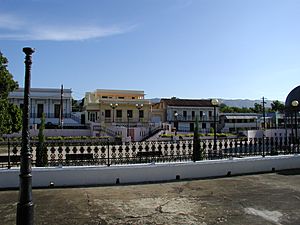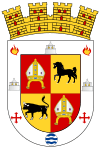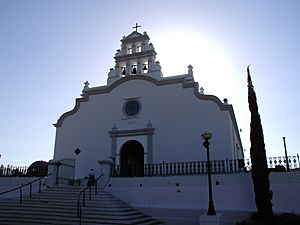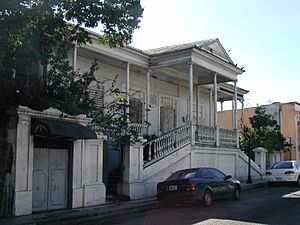Coamo, Puerto Rico facts for kids
Quick facts for kids
Coamo
Municipio Autónomo de Coamo
|
|||
|---|---|---|---|
|
Town and Municipality
|
|||

Coamo from Cerro Picó
|
|||
|
|||
| Nicknames:
"La Villa de San Blás de Illescas", "Los Maratonistas", "La Villa Añeja", "Ciudad de las Aguas Termales"
|
|||
| Anthem: "Allá muy cerca del pueblo" | |||

Map of Puerto Rico highlighting Coamo Municipality
|
|||
| Sovereign state | |||
| Commonwealth | |||
| Settled | early 16th century | ||
| Founded | July 15, 1579 | ||
| Founded by | Don Pedro de Aponte | ||
| Barrios | |||
| Area | |||
| • Total | 78.05 sq mi (202.15 km2) | ||
| • Land | 78.04 sq mi (202.13 km2) | ||
| • Water | 7 sq mi (0,017 km2) | ||
| Elevation | 486 ft (148 m) | ||
| Population
(2020)
|
|||
| • Total | 34,668 | ||
| • Rank | 34th in Puerto Rico | ||
| • Density | 444.174/sq mi (171.496/km2) | ||
| Demonym(s) | Coameños | ||
| Time zone | UTC−4 (AST) | ||
| ZIP Code |
00769
|
||
| Area code(s) | 787/939 | ||
| Major routes | |||
| Website | coamo.puertorico.pr | ||

Coamo is a town and municipality located in the south-central part of Puerto Rico. It was founded in 1579. Coamo is north of Santa Isabel, south of Orocovis and Barranquitas, east of Villalba and Juana Díaz, and west of Aibonito and Salinas.
The town of Coamo and its surrounding areas are nestled in a valley. It's about 20 miles (32 km) east of Ponce. Spanish settlers named it San Blas Illescas de Coamo in 1579. Saint Blaise (San Blas) is the town's patron saint. Illescas is a town in Spain where some of the first settlers came from.
There are different ideas about where the name Coamo comes from. One idea is that it's an old local word meaning "valley." Another idea is that it comes from Coamex (or Coamey), who was a famous local cacique (chief). Scientists have found lots of evidence from pre-Columbian times (before Columbus) in Coamo, showing people lived there long ago.
Coamo is well-known for its natural hot springs, called Los Baños de Coamo. It's also famous for its yearly San Blas Half Marathon. A big battle during the Spanish–American War in 1898, called the Battle of Coamo, happened here.
Contents
A Look at Coamo's Past
Who Lived in Coamo First?
When Spanish settlers arrived, the Taíno people lived in Coamo. Modern discoveries have found proof of at least four Taíno villages in the area that is now Coamo:
- "Buenos Aires" village: Located where Buenos Aires Street is today.
- "Baños de Coamo" village: Found near the hot springs, across the river.
- "Cuyón" village: Located in what is now Cuyón barrio.
- "Las Flores" village: Found west of the Las Flores neighborhood. Special items found here suggest an important chief lived there.
These villages likely had strong connections with other villages near the coast and in the mountains. This is because many seashells were found in Coamo and Cayey, showing they traded or traveled.
After a Taíno rebellion in 1511, the Spanish took control. Over time, many Taíno people became part of Spanish society. This happened because of hard labor, diseases like smallpox, and intermarriage with Spanish settlers.
When Was Coamo Founded?
Coamo was founded on July 15, 1579. It is the third-oldest settlement in Puerto Rico after the Spanish arrived. The first two were San Juan and San Germán. Back then, Coamo was a very important center for a large area. This large area later split into many other municipalities like Guayama, Cayey, and Juana Díaz.
By 1582, about twenty families lived in Coamo. In 1616, Coamo officially became a town. In 1778, the King of Spain gave it the special title of "Villa."
Coamo was the main administrative center for most of the southern part of the island in the early days of the Spanish colony. As farming and sugar production grew, the area divided into more towns. The main center for the region later moved to the coastal town of Ponce.
The Famous Hot Springs of Coamo
Coamo is home to natural hot springs called Los Baños de Coamo. People have visited these springs for their warm, healing waters even before the Spanish arrived. Some even rumored that these springs were Juan Ponce de León's legendary fountain of youth.
In the early 1800s, pools were built at the springs to create a spa for the colonists. During the Spanish–American War in 1898, a major battle took place here. After the American troops took over the island, the spa was left empty. For most of the 1900s, the site was in ruins, but locals still went there to bathe. Today, the pools are still there, and a popular hotel and rest area has been built around the old ruins.
Puerto Rico became a territory of the United States after Spain lost the Spanish–American War and signed the Treaty of Paris of 1898. In 1899, a census showed that Coamo had a population of 15,144 people.
Hurricane Maria's Impact
On September 20, 2017, Hurricane Maria caused many landslides in Coamo due to heavy rain. After the hurricane, many homes were damaged or destroyed. The famous Hotel Los Baños de Coamo was completely ruined. It took a long time for electricity and clean water to return to the area.
Coamo's Geography
Coamo is located in the South Central region of Puerto Rico.
What are Coamo's Barrios?
Like all municipalities in Puerto Rico, Coamo is divided into areas called barrios. The main town area, where the government buildings, central square, and Catholic church are, is called "el pueblo".
What are Sectors?
Barrios are further divided into smaller areas called sectores (which means sectors in English). These sectors can have different names like urbanización or barriada.
Special Communities in Coamo
Some communities in Puerto Rico are called Comunidades Especiales (Special Communities). These are areas where people might face challenges like social exclusion. In 2014, some of these special communities in Coamo included the Zambrana neighborhood, Cuyón, Sector Varsovia in El Cerro, Río Jueyes, and Sector Sabana Hoyo.
Coamo's Economy
Farming in Coamo
Coamo is an important farming area. Farmers here grow fruits like mangoes, guanabanas, tamarindo, quenepas, avocados, and oranges. They also grow corn and plantains. Raising poultry (like chickens) and cattle (cows) is also a big part of the economy.
Industries in Coamo
Coamo is a place where different goods are traded. Industries here include making machinery, parts for aircraft radios, and clothing.
Visiting Coamo: Tourism
The Puerto Rico Tourism Company has a program called Voy Turistiendo ("I'm Touring") to encourage local tourism. The Coamo page suggests visiting the Aguas Termales de Coamo (Coamo Thermal Waters), Iglesia San Blas de Illescas (San Blas Church), and Mirador Cerro Picó (Cerro Picó Lookout).
What are the Main Landmarks?
There are eight places in Coamo that are listed on the US National Register of Historic Places. This means they are important historical sites.
- Casa Blanca de Coamo
- Ermita Nuestra Señora de la Valvanera (a small chapel)
- Iglesia San Blas de Illescas: This church started being built in 1661 and is one of the oldest churches in Puerto Rico.
- Puente de las Calabazas (Calabazas Bridge)
- General Méndez Vigo Bridge
- Puente Padre Iñigo (Father Iñigo Bridge)
- Picó Pomar Residence: This building is now a museum.
- Carretera Central: A historic highway that goes through Coamo.
Other important landmarks in Coamo include:
- Los Baños de Coamo (Coamo Thermal Baths)
- Puente de Las Flores (Las Flores Bridge)
Coamo's Culture
Festivals and Events in Coamo
Coamo celebrates its patron saint festival in February. This festival, called Fiestas Patronales de San Blas Illescas y La Virgen Candelaria, is a religious and cultural event. It usually has parades, games, local crafts, fun rides, traditional food, and live music.
Other fun events in Coamo include:
- San Blas Half Marathon – Held in February.
- Crafts festival – Celebrated in June, honoring the municipal flag.
- Coamo Anniversary – Celebrated in July.
- Christmas tree lighting and concert – Held in December.
Sports in Coamo
Coamo is very famous for hosting the San Blas Half Marathon. This is a world-class professional marathon held every year. It attracts some of the best runners from all over the world. The race started in 1963 to honor the town's founder. It's Puerto Rico's biggest race, and many people come to watch.
The Maratonistas de Coamo is the town's professional basketball team. They play in the BSN league and have been in Coamo since 1985.
Coamo's Population
| Historical population | |||
|---|---|---|---|
| Census | Pop. | %± | |
| 1900 | 15,144 | — | |
| 1910 | 17,129 | 13.1% | |
| 1920 | 17,749 | 3.6% | |
| 1930 | 18,125 | 2.1% | |
| 1940 | 22,772 | 25.6% | |
| 1950 | 26,485 | 16.3% | |
| 1960 | 26,082 | −1.5% | |
| 1970 | 26,468 | 1.5% | |
| 1980 | 30,822 | 16.5% | |
| 1990 | 33,837 | 9.8% | |
| 2000 | 37,597 | 11.1% | |
| 2010 | 40,512 | 7.8% | |
| 2020 | 34,668 | −14.4% | |
| U.S. Decennial Census 1899 (shown as 1900) 1910-1930 1930-1950 1960-2000 2010 2020 |
|||
Transportation in Coamo
There are 31 bridges in Coamo, helping people travel around the municipality.
Education in Coamo
Coamo's very first school was built in 1901, showing its commitment to learning.
Symbols of Coamo
The municipality of Coamo has its own official flag and coat of arms.
Coamo's Flag
The flag of Coamo uses colors from its coat of arms: red, yellow, and black.
Coamo's Coat of Arms
The coat of arms has different symbols. The top left and bottom right parts are red with a gold Episcopal hat, representing the old area of San Blas de Illescas. A horse and a bull show the importance of cattle in the area. The gold and black colors remind us of the yellowish-red fields of Coamo during dry times. The border of the coat of arms includes two flames, three bell towers with gold bells, two red crosses, and a circle with blue and silver stripes.
Famous People from Coamo
Many notable people come from Coamo, including:
- Lely Burgos: An Olympic athlete.
- Bobby Capó: A famous singer and composer.
- Margarita Nolasco: A senator and former Vice-President of the Senate of Puerto Rico.
- Antonio García Padilla: Former President of the University of Puerto Rico.
- Jose Garriga Pico: A former senator.
- Willie Rosario: A musician, composer, and bandleader known for salsa music.
- Alejandro García Padilla: A former Governor of Puerto Rico.
- Victor Caratini: A professional baseball catcher for the Milwaukee Brewers.
Images for kids
See also
 In Spanish: Coamo para niños
In Spanish: Coamo para niños






